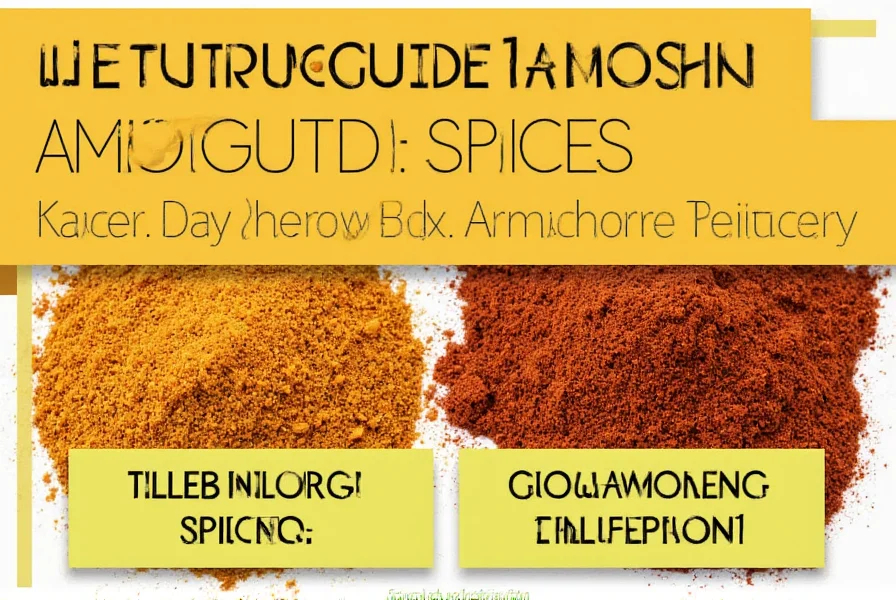Curry spices are essential for adding depth and flavor to dishes. This guide provides expert tips on how to use, store, and select curry spices for perfect results every time. Whether you're a beginner or experienced cook, these actionable steps will help you master curry spices in your kitchen.
| Curry Spice Type | Key Ingredients | Flavor Profile | Best Uses |
|---|---|---|---|
| Indian Curry Powder | Turmeric, cumin, coriander, mustard seeds | Earthy, warm, moderately spicy | Chicken tikka masala, lentil dals, vegetable stir-fries |
| Thai Green Curry Paste | Lemongrass, galangal, kaffir lime leaves, green chilies | Fresh, citrusy, aromatic | Green curry with coconut milk, stir-fried vegetables |
| Thai Red Curry Paste | Dried red chilies, garlic, shallots, coriander root | Rich, smoky, medium heat | Red curry with shrimp, roasted vegetables |
| Caribbean Jerk Seasoning | Allspice, scotch bonnet peppers, thyme, cloves | Smoky, spicy, sweet undertones | Grilled chicken, jerk pork, roasted sweet potatoes |
How to Use Curry Spices Correctly
Follow these science-backed techniques to maximize flavor:
- Toast whole spices first in dry pan for 1-2 minutes until fragrant before grinding. This releases essential oils for maximum aroma.
- Combine with fat (oil, butter, or coconut milk) before adding liquids. Heat spices in oil for 30 seconds to bloom flavors.
- Add acidic ingredients like lime juice or tomatoes after cooking spices to balance heat and enhance complexity.
- Use precise measurements - start with 1 teaspoon per serving and adjust gradually. Overpowering spices can ruin a dish.
- Pair with complementary ingredients like cilantro, coconut, or yogurt to create balanced flavor profiles.
Buying Guide: What to Look For
When purchasing curry spices, prioritize these quality indicators:
- Harvest date - fresh spices should have a clear production date (avoid "best by" dates only)
- Whole vs ground - whole spices retain freshness 2-3x longer than pre-ground versions
- Storage conditions - look for opaque, airtight packaging that blocks light and moisture
- Origin transparency - reputable brands specify spice origins (e.g., "Indian turmeric from Kerala")
Proven Storage Methods
Extend spice freshness with these techniques:
- Store in dark glass jars away from heat sources (not above stove)
- Keep whole spices in freezer for 2+ years of freshness
- Grind spices just before use for maximum potency
- Avoid moisture exposure - never use wet spoons to scoop spices
Common Mistakes to Avoid
- Adding spices too early in cooking (causes bitterness)
- Using expired spices (check aroma - should be strong and vibrant)
- Substituting curry powder for curry paste (different flavor profiles)
- Overusing spices without balancing with fats or acids
What's the difference between curry powder and curry paste?
Curry powder is a dry spice blend typically used in Indian cuisine, while curry paste contains fresh ingredients like lemongrass, galangal, and chilies mixed with dried spices. Paste is used for Thai curries and requires cooking in oil first, while powder can be added directly to liquids.
How long do curry spices stay fresh?
Ground spices maintain peak flavor for 6-12 months when stored properly. Whole spices last 2-3 years. Test freshness by rubbing a small amount between fingers - if aroma is weak or color faded, replace them.
Can I make my own curry spice blend?
Yes! For a basic Indian blend: toast 2 tbsp cumin seeds, 2 tbsp coriander seeds, 1 tbsp mustard seeds, then grind with 1 tbsp turmeric, 1 tsp fenugreek, and 1/2 tsp cardamom. For Thai curry paste, blend fresh lemongrass, galangal, kaffir lime leaves, and chilies with dried spices.
Real-World Application Examples
- Breakfast: Add 1/2 tsp curry powder to scrambled eggs with coconut milk for a fragrant twist
- Snacks: Toss roasted chickpeas with 1 tsp curry powder and olive oil for protein-packed crunch
- Marinades: Mix 2 tbsp curry paste with yogurt for tenderizing chicken or tofu
- Soups: Stir 1 tsp curry powder into tomato soup for depth of flavor
Professional chefs recommend starting with small amounts of spices and gradually increasing to taste. Remember: "A little curry spice goes a long way" when applied correctly.











 浙公网安备
33010002000092号
浙公网安备
33010002000092号 浙B2-20120091-4
浙B2-20120091-4